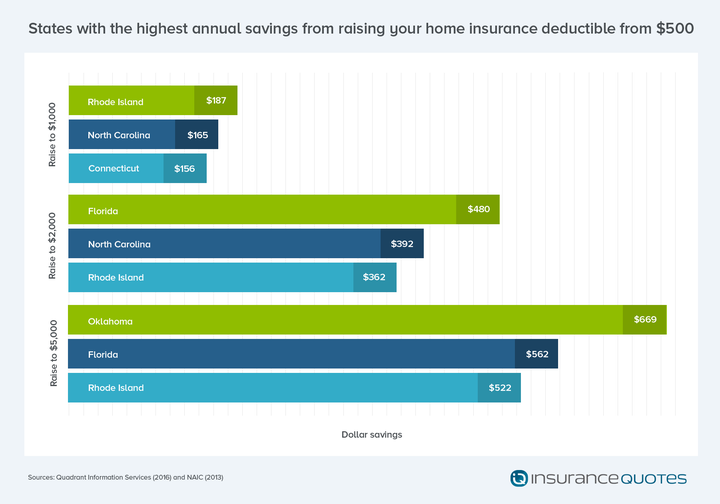Raising the deductible on your home insurance policy is one proven way to save money on your premiums, but it’s not the best financial decision for every homeowner.
Before you reach for the phone to bump up your deductible there are two important factors to consider: Do you have enough money saved to cover higher out-of-pocket claim costs, and have you discussed potential savings and ramifications with an insurance agent?
This article was originally published on insuranceQuotes.com.
“The bottom line is that you want to make sure you are comfortable with the deductible amount you’ve selected,” says Stacy Molinari, personal lines and claims manager of Insurance Marketing Agencies, Inc. “And that means you need to make sure you have enough of a financial cushion to cover the deductible. Otherwise it could cost you more in the long run.”
So, just how much savings are out there when switching to a higher deductible? Let’s break it down by looking at a report commissioned by insuranceQuotes
The 2016 Quadrant Information Services study examined the average economic impact of increasing a home insurance deductible (i.e. how much you pay out of pocket for a claim before your insurance coverage kicks in). Using a hypothetical two-story, single-family home covered for $140,000, the study looked at how much an annual U.S. home insurance premium can decrease after increasing the deductible.
According to the National Association of Insurance Commissioners (NAIC), the average home insurance premiums is $1,034, and the study examined three different percentage increases and their respective premium savings:
Increase from $500 to $1,000: 7 percent savings.
Increase from $500 to $2,000: 16 percent savings.
- Increase from $500 to $5,000: 28 percent savings.
What makes home insurance deductibles so significant?
In short, a home insurance deducible is one of many gauges an insurance company uses to determine how much risk the consumer is willing to accept. A higher deductible means more risk being taken on by the homeowner, and that additional risk makes it cheaper to insure the policyholder.
“A higher deductible is a signal to the insurance company that the homeowner is less likely to file claims because they are agreeing to a higher threshold for doing so,” says David Reiss, law professor and research director at Brooklyn Law School’s Center for Urban Business Entrepreneurship. “And the less likely you are to make a claim, the lower your premium is going to be.”
In other words, deductibles either encourage or discourage the filing of claims. If, for example, someone has a $500 deductible, he or she is more likely to file a claim than someone with a $5,000 deductible.
“Insurance companies don’t make money when they are paying out a lot of small claims at $500 or $1,000,” says Jonathan Stein, a California-based consumer law attorney who specializes in insurance. “So increased deductibles mean a decrease in the number of claims, and the insurance company saves more money.”

How much you save on insurance premiums varies by state
When it comes to insurance no two states are created equal, and this means the savings you’ll see from increasing your home insurance deductible will depend on where you live.
For instance, North Carolina residents save, on average, 39 percent when increasing a deductible from $500 to $2,000. And when increasing from $500 to $5,000 they save an average of 45 percent on home insurance (the most significant difference in the country). In fact, North Carolina had the highest percentage savings from deductible increases in all three categories.
Meanwhile, Rhode Island residents see the second-highest savings when increasing home deductibles to $1,000 or $2,000 (14 and 27 percent respectively), and homeowners in Oklahoma see the second-highest savings when increasing their deductibles to $5,000 (40 percent).
Conversely, residents of Texas and Wyoming save, on average, less than 3 percent by increasing their deductibles to $1,000, and homeowners in Texas, Hawaii and Indiana will, on average, save less than 7 percent on their home insurance premiums by increasing a deductible to $2,000.

Industry experts and analysts say the reasons for these state-by-state differences are complex.
Mike Barry, spokesman for the nonprofit Insurance Information Institute, says it’s important to point out that many states with the most significant savings are those that also have a very high risk for natural disasters, such as hurricanes and tornadoes.
“If you’re living in a state with a significant number of natural disasters and you, as a policyholder, are willing to absorb more of the risk with a higher deductible, your insurer is going to give you a more substantial break in your premium,” Barry says.
To that end, any potential savings will depend on the state you call home.
“If there’s no significant savings to be had in your state, it doesn’t make sense to increase your deductible,” Stein says. “But if you can save the increased deductible amount — $500 for example — in less than five years, then it makes sense, especially if you don’t plan on moving.”
Are you financially prepared to increase your deductible?
Sure, an increased deductible may shave money off your annual premium, but that means nothing if you don’t have enough cash to cover it in the event of a loss.
“The financial plan is simple: Be certain you can pay the deductible amount if you have to,” says Josh Hite, owner of the Florida-based Brightway Insurance Agency. “The insurance company isn’t going to look at your bank records to make sure you have enough money tucked away. It’s up to you to make sure you can cover the expense if you file a claim.”
Molinari says it’s important to understand that a deductible is not a sum of money collected by insurers. Rather, in the event of a loss, an insurance company will pay the amount of the covered loss minus the deductible.
TAKE THE QUIZ: How Well Do You Know Your Homeowners Policy?
“This is important because even though you’re not writing a check for your deductible amount you must have enough money saved to cover the additional expense,” Molinari says. “If you don’t, you might have to put off making certain repairs, which can cause you to incur additional expenses if your home isn’t livable.”
Even if you’re financially prepared to put away enough money to cover your deductible, Stein says homeowners still need to consider whether an increased deductible will result in substantial savings — and this requires some simple math.
For example, if you increase your deductible from $500 to $1,000 but only save $10 per year, then you need 50 years of insurance to save the extra $500. If, however, a $500 increase saves you $200 per year, then you are saving money within two-and-a-half years.
“Homeowners need to do this math to figure out if the savings are worth the increased burden of a higher deductible,” Stein says.
Talk to an insurance agent about changing your deductible
No one knows the nuances of your home insurance policy better than your agent, so before making any decisions about your deductible you need to get his or her advice.
For instance, Molinari says she always begins the deductible conversation by finding out what a client’s risk tolerance is.
“I like to ask my clients, ‘How big would a loss have to be for you to file a claim?’ The answer to that question usually helps both the client and myself with selecting a deductible,” Molinari says. “Often times I find that clients are paying for a $500 or $1000 deductible but they would never consider filing a claim for $1000.
These clients should not pay for a benefit they would never use.”
Also, talking to your insurance agent may alert you to deductible options you may have never considered. For instance, some carriers will offer something called a large loss deductible waiver. This is typically an inexpensive endorsement or comes built into some home insurance policies.
For example, a policy may have a large loss deductible waiver if the claim exceeds $50,000 as long as the homeowner elected to have a deductible less than $50,000. So if the homeowner has a $25,000 deductible and a $50,000 loss, they don’t pay a deductible at all.
“This is a great option on high value home policies and for those who can take the hit of a larger deductible,” Molinari says.
Finally, make sure you are regularly reviewing your policy with your agent and doing a market comparison every three years to make sure your current insurer is still the right one for you.
“Appetites, markets and rates change, and your agent should always be aware of this,” Molinari says. “Changing your deductible isn’t the only way to reduce your insurance costs.”
Laura Adams is a personal finance expert, award-winning author, host of the top-rated Money Girl Podcast, and insuranceQuotes’ senior analyst. For more on auto, home, health, life, and business insurance, click here.
